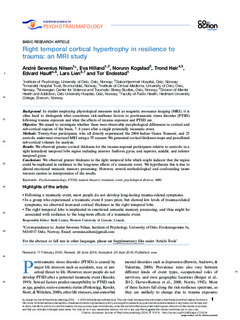Right temporal cortical hypertrophy in resilience to trauma: an MRI study
Nilsen, Andre Sevenius; Hilland, Eva; Krogstad, Norunn; Heir, Trond; Hauff, Edvard; Lien, Lars; Endestad, Tor
Abstract
Background: In studies employing physiological measures such as magnetic resonance imaging (MRI), it is often hard to distinguish what constitutes risk-resilience factors to posttraumatic stress disorder (PTSD) following trauma exposure and what the effects of trauma exposure and PTSD are. Objective: We aimed to investigate whether there were observable morphological differences in cortical and sub-cortical regions of the brain, 7–8 years after a single potentially traumatic event. Methods: Twenty-four participants, who all directly experienced the 2004 Indian Ocean Tsunami, and 25 controls, underwent structural MRI using a 3T scanner. We generated cortical thickness maps and parcellated sub-cortical volumes for analysis. Results: We observed greater cortical thickness for the trauma-exposed participants relative to controls, in a right lateralized temporal lobe region including anterior fusiform gyrus, and superior, middle, and inferior temporal gyrus. Conclusions: We observed greater thickness in the right temporal lobe which might indicate that the region could be implicated in resilience to the long-term effects of a traumatic event. We hypothesize this is due to altered emotional semantic memory processing. However, several methodological and confounding issues warrant caution in interpretation of the results.
